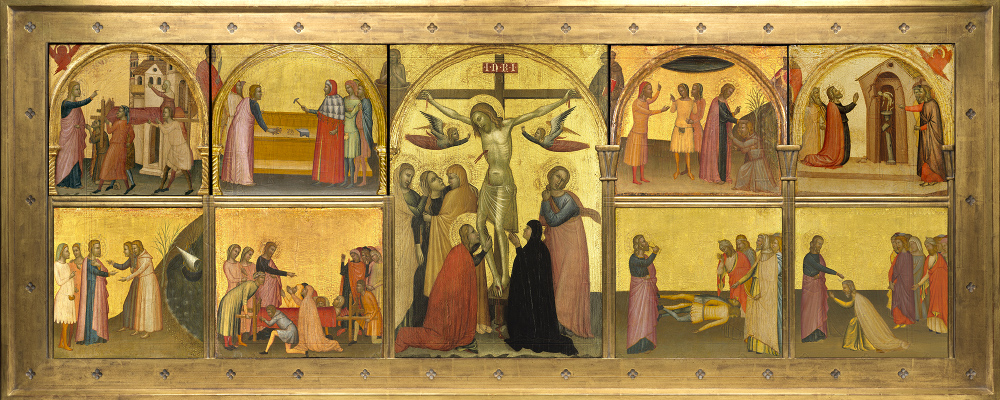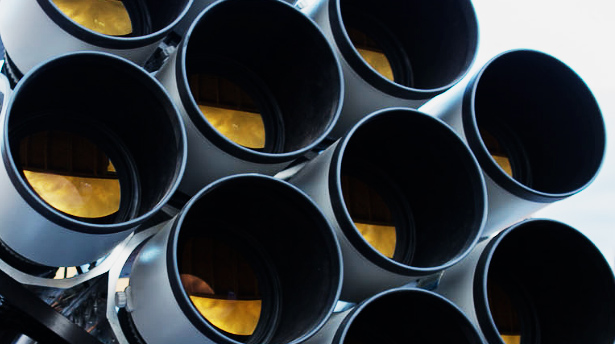Using Mathematics to Repair a Masterpiece
Mathematics is everywhere, if you know where to look.
A recently opened exhibition at the North Carolina Museum of Art (NCMA) is displaying the St. John Altarpiece, a 14th-century work by Francescuccio Ghissi. It has nine scenes in total: eight smaller pictures featuring St. John the Evangelist flanking a larger central Crucifixion. At the end of the 19th century, the altarpiece was separated into parts by a saw and eight of the nine resulting panels were sold to different collectors. One panel, the last of the smaller scenes, was lost.
Mathematics has played an integral role in allowing the panels to be displayed for the first time in over 100 years. The work has been part of a project that several of my colleagues and I have been involved with. We have developed new mathematical techniques that can not only reverse the observed effects of aging, but also untangle and remove the effects of well-intentioned but now-regretted conservation efforts. These techniques are now available for other art conservators around the world to apply to their artworks.
Quantized
A monthly column in which top researchers explore the process of discovery. This month’s columnist, Ingrid Daubechies, is the James B. Duke Professor of Mathematics and Electrical and Computer Engineering at Duke University.
There’s no single starting point for the story, as mathematical image analysis has been in use for years, and in many guises. But a key event was the restoration of another masterpiece, and the settling of a question that had divided art historians for decades.
In the 15th century the brothers Hubert and Jan van Eyck created the Ghent Altarpiece, a grand work of art that consists of 12 panels, eight of them connected by hinged shutters. When the polyptich is closed, the far right panel at middle height shows an Annunciation scene; in the background, propped up on a stand, is the page of a book with medieval writing. It was not clear, however, whether the van Eycks had painted only a book’s symbolic representation or its actual text. If the latter, then art historians wanted to identify that text.
The portion of the painting in question is covered with fine cracks in shades of brown, very similar to the paint used for the letters themselves, with many cracks slanted in directions similar to the strokes of the letters. These cracks impeded the reading of the putative text, even by experts in deciphering manuscripts in the hard-to-read medieval writing.
In 2010, art conservators began an extensive restoration campaign of the Ghent Altarpiece. As part of this project, the panels were photographed with exquisitely high precision. Here was the chance to decipher the putative text of the polyptich. My colleagues and I were asked by the art historian Maximiliaan Martens whether we could, with such high-resolution scans, bring mathematics to bear on the problem.
Our work consisted of two main steps: finding a way to automatically detect the numerous cracks, and then in-painting (or eliminating) them. The latter was handled with state-of-the-art methods developed by others. But detecting the cracks turned out to be a harder nut to crack. In the end, we had to rely on X-ray images of the panels, in which the cracks stood out the best, and a combination of several filtering methods, each adapted to the data.
After in-painting the cracks, the resulting would-be text looked as undecipherable to us as before. But not to paleographers. They identified 12 word groups that made it clear that the van Eycks had painted an actual text. To the delight of the art historians, they identified it as a theological text written by Thomas Aquinas on the Annunciation and copied by scribes in Flanders at the start of the 14th century.
The experience we gained on this project would prove critical for the Ghissi Reunification project. In preparing for the exhibition, Dutch artist and art reconstruction expert Charlotte Caspers was commissioned to paint a replacement for the lost panel. Together with NCMA curator David Steel, she designed a composition in Ghissi’s style; the subject of the scene was determined from the Golden Legend, a medieval bestseller chronicling lives of saints and the source material for the first seven small panels.
When the replacement panel was ready, it vividly demonstrated how bright and sparkling the altarpiece must have been when it was new. But it also became apparent that the Caspers panel could not simply be displayed next to the other eight panels in the same frame. It would distract the viewer too much from the aged and discolored originals, though they were authentic in a way the new panel was not.
Mathematical analysis allowed us to help. After studying the old panels as well as the new, we made a high-resolution digital version of the new panel in which the gold looked duller and the colors more subdued to mimic 650 years of aging pigment. We also added a believable crack pattern. In short, we virtually aged the panel. A printout of this aged version now completes the St. John Altarpiece.
The same technical analysis can also be applied in the reverse direction: After fine-tuning the digital image manipulations to make the transition from new to old, we also wanted to take high-resolution images of the existing panels and map their old, aged colors to corresponding “freshly painted” versions, thus rejuvenating the 14th-century work. Importantly, we also needed to detect and in-paint the cracks, something we had learned how to do with the Ghent Altarpiece.
In the Ghent crack-removal work, X-ray images of the altarpiece had proven essential, so we asked the NCMA conservators for X-ray photos of the St. John Altarpiece panels. The most dominant feature in each of these X-ray photographs was an annoying overlaid lattice structure. This, it turned out, was due to cradling, a fairly standard conservation practice in the 19th and early 20th centuries. To reduce warping, conservators planed the thickness of the wood-panel support of old European paintings, down to one centimeter or even less. To the back of the resulting, thinner board, they then attached a hardwood lattice or cradle. This lattice consisted of fixed members in the direction of the wood grain of the board and sliding members perpendicular to the wood grain that tunneled through the fixed members.
Cradling did not hold up over time. In extreme cases, wood panels have reacted to the stress constraints of cradling by developing such large cracks that specialists are called in to carefully remove the cradle and replace it with a less rigid support structure that allows the panel its natural warping freedom. It’s a very tricky and expensive process.
To the annoyance of conservators, the cradle lattice structure hides from view the painting and conservation repair details that one usually tries to glean from X-ray pictures. When we wondered whether mathematical analysis and image processing could possibly help in removing these artifacts virtually, our tentative suggestions were met with fervent enthusiasm, and art conservators in several different museums volunteered a variety of data for us to try out our ideas. Especially helpful were rare instances of X-ray images of the same painting with and without cradling, crucially important for verifying our computational results. Rujie (Rachel) Yin, a graduate student in mathematics at Duke University, led the work.
This project turned out to be our biggest challenge yet. One complication is that wood grain varies a lot, even within one piece of wood. This makes it hard to identify a wood grain texture reliably when other fine-grained and elongated textures are present as well — as is likely in an X-ray of a painting that reveals brushstroke patterns that the conservators want to distinguish better. The aim of removing only cradle wood grain makes the task extra challenging, since that wood grain is never observed in isolation. The cradled regions contain the wood grain of both panel and cradle, while cradle-free regions contain wood grain from only the panel. (Sadly, identifying this grain pattern isn’t much help, since the panel’s grain will be different, just a few centimeters over.)
We turned to machine-learning algorithms to separate the features into those more likely to pertain to the panel and others more likely from the cradle. The algorithm that we developed achieves good results when the cradle and panel wood-grain textures are reasonably different. Unfortunately in the Ghent Altarpiece, the same wood — Flemish oak — was used for both the panel and the cradle, and the algorithm has some trouble parsing the grain. In addition, the algorithm is quite slow.
Fortunately, the target users are among the most patient people on the planet: Art conservators typically don’t bat an eyelid at having to clean paintings with Q-tips and distilled water, so having to let an algorithm run for a few hours is perfectly acceptable to them. Yin’s proof-of-concept code has since been transformed into a more robust version, with an interface that can be used by art conservators; the open-source software can be freely downloaded.
In the new exhibition, both new and old versions of the altarpiece are shown on a large video screen, alongside short documentaries featuring the image processing and a (very impressionistic) explanation of the mathematics that went into the rejuvenation and “aging” processes.
We are now working on other problems. For instance, in those rare cases in the 19th century when a wood panel, painted on both sides, was not split, so that both sides could be displayed simultaneously, the X-ray image of the panel shows all the typical details that stand out more than they do in a visible-light picture — but for both sides, mixed. Can one split this into two virtual X-ray images, using as side information the two visible-light pictures? This is again a challenging problem, and we have preliminary results, but hope to become better at it. Other problems await as well.
So far, our work with art historians and art conservators has provided interesting mathematical problems that have already led us far beyond a simple application of off-the-shelf tools. We have not yet had to build new mathematical theory, but I expect it is just a matter of time; I would be willing to stake a serious bet that it will happen in the next 10 years. And I also bet that 10 years ago, none of our collaborators from the art world would have predicted the value of mathematics in their own work.
They have discovered what we always knew — that math is everywhere.
This article was reprinted on Wired.com.




